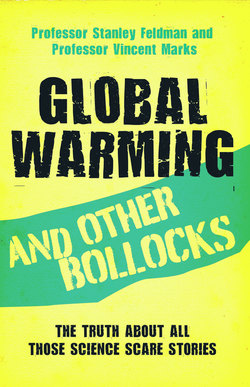Читать книгу Global Warming and Other Bollocks - Stanley Feldman - Страница 17
На сайте Литреса книга снята с продажи.
THE HISTORY OF THE ATMOSPHERE
ОглавлениеSTANLEY FELDMAN
DOGMA
We know that mankind causes global warming.
AS THE MOLTEN MASS that was to form our planet solidified, the gases from volcanic eruptions and constant asteroid bombardment came to determine the composition of its atmosphere. It is thought to have resulted in an atmosphere largely made up of water vapour, with around 15–20 per cent of carbon dioxide (planets such as Venus and Mars contain about 95 per cent CO2 in their atmosphere). Other gases that were present, as minor players, included sulphur dioxide, carbon monoxide and nitrogen. Even before the advent of plant life and photosynthesis, the concentration of CO2 was decreasing as more and more of it became converted to chalk and sand under the very high temperatures that were present as the fiery Earth started to cool. The greenhouse-gas effect of the huge amount of CO2 in the atmosphere up to 50 million years ago did not prevent the molten mass of Earth from cooling, although it may have slowed the process.
Figure 3.1: Deep sea temperature – in spite of very high levels of CO2, Earth continued to cool. For the past 50 million years the level of CO2 has remained historically low.
Although the first evidence of life can be traced back some 2–3 billion (thousand million) years, it was not until about 400–500 million years ago that the first recognisable animal life forms appeared. By this time it is calculated that the CO2 concentration in the atmosphere had decreased from 15–20 per cent to 4–5 per cent. By the time the first marine organisms emerged on to the swampy land, many millions of years later, the CO2 levels had fallen still further, to about 1.5 per cent in the atmosphere, many times higher than today.
In spite of the enormously high levels of CO2 in the planet’s atmosphere when it was born, the Earth cooled down. This is not surprising, since it was originally very much hotter than the surrounding atmosphere. There is evidence that the cooling continued, even when the surface became much colder, causing large parts of the planet to be covered with ice. It is believed that this occurred about 600 million years ago; it was the time of ‘Snowball Earth’, just before multi-cellular life forms appeared. The period of Snowball Earth was followed by several million years of warming.
The finding of fossil remains of gastropods in the trans-Antarctic mountains near the south pole is good evidence that the Antarctic was much warmer than today – indeed, warm enough to support animal life – about 15 million years ago. This means that the huge glaciation that formed the Antarctic must have occurred when the CO2 levels in the atmosphere were over 0.5 to 1.0 per cent. Although no one can be certain of the CO2 level at this time or the exact extent or duration of the glaciation, it is evident that, in the past, Earth has cooled to very low temperatures in spite of very much higher levels of CO2 than is present today.
None of this is proof that CO2 has not been important as a global greenhouse gas in the past or that it does not play a part in determining the present temperature of our planet. However, it does indicate that high levels of CO2 in the atmosphere are not incompatible with global cooling. It must be borne in mind that many of the figures quoted are based on assumptions and calculations. This is why much of the argument about global warming has centred on what is happening now and how this relates to the period that we can measure with some accuracy, the past 1,000–2,000 years (see Figure 3.2).
Figure 3.2: Temperatures on the surface of the Sargasso Sea over 3,000 years – evidence from isotope studies of marine organisms
